Gamebore Target Loads Cross the Atlantic to the U.S. Market
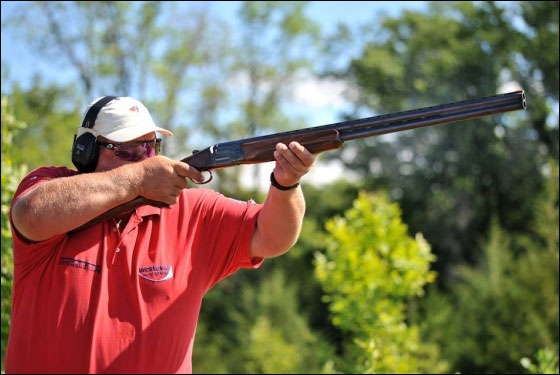
New on the U.S. import scene is a four-load selection of Kent Gamebore lead target loads imported exclusively by Will Krawczyk of W.T. Sherman and Company since January 2015 and conveniently sold on their web site. These British-made shotgun shells will not be “value-priced” cheapies. Instead they have been selected to compete with American-made, high-end, lead-shot target loads. The Gamebore White Gold load being imported is expected to retail at somewhere between $83 to $90 per 250-round case. Two other loads – Black Gold and Platinum Trap − will sell for about $90 to $95 per case.
I tested each of the four Gamebore target loads sent me by first cutting apart at least three sample rounds per load, then weighing the shot charges and micing the pellets to check pellet size. Then I fired 25 rounds of each load through a Remington Model 32 over/under with 30-inch barrels and fixed modified and full chokes. The rounds were fired at White Flyer standard clays thrown to present angling-away shots over a 140-degree fan and presenting striking distances of 30 to 45 yards. I felt these distances and the quartering-away angles would be a good test of the loads’ target breaking ability, because these are common angles and distances for both trap shooting and many of the longer stations on sporting clays courses.
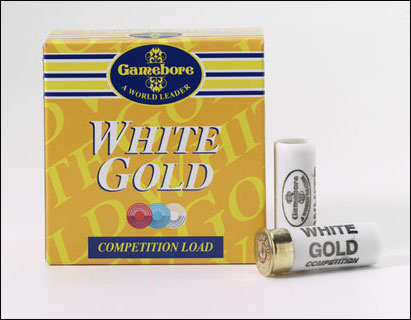
The shot size in the one-ounce Gamebore White Gold lead target load sent me was stamped No. 8. They miced out an average diameter of .091 inch which makes them true to a U.S. No.8 (.090 inch). A 10-pellet sample measured for diameter revealed beautifully round and uniform, silver-colored lead shot called by Kent “Diamond Shot.” The silver color gives the appearance of nickel plating, but is actually just a coloring artifact from high polishing.
The marketing term “Diamond Shot” implies hardness, and this load’s shot checked out as containing 5-percent antimony in a crush test. I have yet to test any European or British-made lead shot that tests any harder than a 5-percent antimony level, and thus far never as high as U.S.-made “magnum grade” lead shot which tests a consistent 6 percent.
The load is assembled in a Gualandi one-piece plastic wad and proved to have a true one-ounce payload which averaged 1289 feet per second through my chronograph, nearly matching the manufacturer’s claimed velocity level of 1295 feet per second. The load is served up in a two-piece white plastic hull with a six-point crimp and a brass, medium-height metal head. I found the White Gold load very clean-burning with modest recoil and it broke clay targets nicely. This load is endorsed on the box by George Digweed − most successful multi-world and European clay pigeon shooting champion in the world with 23 World titles (13 Sporting and 9 FITASC), 18 European championships, 10 British & English championships and 16 World Cups to his credit.
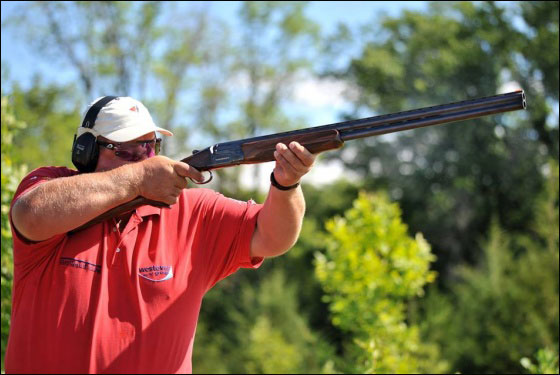
George Digweed
The Black Gold Ultimate Performance load sent me was also stamped “one ounce” carrying No. 8 shot. Inside I found a true one-ounce shot charge of slightly less polished lead shot than the White Gold load, served up in a slightly different Gualandi one-piece plastic wad. My 10-pellet sample check revealed a pellet diameter with a high degree of variability. The pellets varied in diameter from .081 inch (U.S. No. 9) to .094 inch (U.S. No. 7½) and averaged .0867 inch or about a U.S. No. 8½ with about a 5-percent antimony content.
Advertised as possessing a 1350 feet per second velocity level (which also proved true through my chronograph), I expected a fairly high level of recoil. Despite my anticipation, I actually experienced less recoil than with the White Gold load. Examining the load more closely I found it was assembled in a B&P Gordon System hull with a high, silver-colored metal head. The Gordon System hull features a small cushioning section built into the basewad of the two-piece hull and this plus the Gualandi wad loaded had to be the main contributors to the fairly pleasant recoil level experienced. This load did not break targets quite as well at the longer distances as the White Gold load, which I attributed to the fact that the pellets actually averaged U.S. No. 8½ rather than U.S. No. 8.

Turning to the Gamebore Platinum Trap No. 7½ lead load, I fully expected a lower recoil sensation than the previous two loads. This is because first, it’s only a 7/8-ounce load advertised as traveling 1280 feet per second, which checked out as 1270 feet per second on my chronograph. Secondly, it’s loaded in a six-point crimp, black-plastic, straight-walled B&P Gordon System hull with silver-colored high metal head. I found the wad loaded to be a B&P one-piece target wad.
Again a close shot examination turned up Diamond Shot which miced out at an average of .0898 inch making the pellets a U.S. No. 8 (.090 inch) rather than U.S. 7½’s (.095 inch). Regardless, the load broke clays quite soundly, even on the second shot when the clays were easily exceeding the 40-yard mark. I found this load to also be very clean burning, developing quite modest recoil with the shot containing about a 5-percent antimony level.
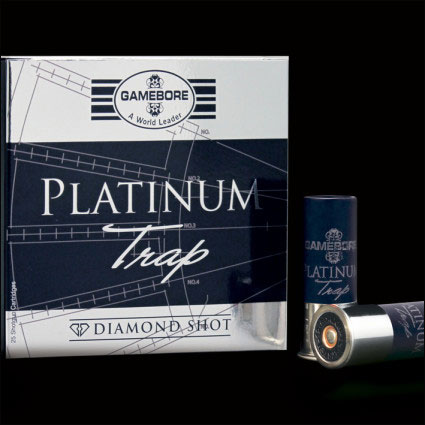
Last up was the EVO Competition load in No. 8 shot. This is another one-ounce lead load at an advertised velocity of 1260 feet per second. The load is assembled in a low brass head, two-piece plastic transparent blue hull with a Gualandi one-piece wad. The shot loaded was definitely not Diamond Shot but rather distinctly black in color and softer than the shot in the other three loads.
The ten pellet sample I miced tested out with an average diameter of .0827 inch with a low variation from .081 to .085 inch. But the .0827-inch diameter makes the pellets a slightly undersized U.S. No. 8½, not a U.S. No. 8. Target breaks got shaky beyond 40 yards, but were perfectly adequate at 35 yards or less. The EVO load will possess a more modest price-point of about $70 to $75 per case.
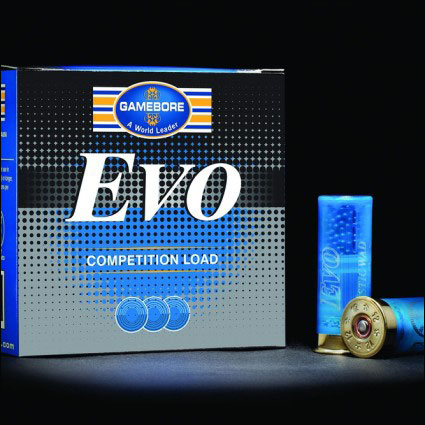
As with all European shotshell ammunition initially imported into the U.S., the Gamebore target loads I tested need a bit of tweaking. One area involves velocity. I advise Gamebore to stamp the top of each shotshell box with the 3-foot (2.5 meter) instrumental velocity. American shooters are very interested in this detail. Also, the disparity between the actual diameters I miced for shot versus the shot size currently stamped on the Gamebore target load boxes is not intentionally misleading, but it becomes so. That’s due to the different actual diameter specs for British or European shot size standards versus U.S. standards for the same pellet name designation. Ultimately to be successful in the U.S., the shot size stamped on the box has to be true to U.S. diameter standards to please American shooters.
Useful resources
Tom Roster is an independent ballistics consultant and author specializing in the design and testing of shotshell loads for U.S. shotshell and reloading components manufacturers. He is a court-recognized shotshell/shotgun expert witness. Tom was formerly the Ballistics Research Director at Oregon Institute of Technology and then served as a Ballistics Specialist for the Dept. of the Interior. In these capacities he designed and administered the world’s six most extensive lead versus nontoxic shot duck, goose, pheasant and dove shooting tests ever conducted. He then co-authored their peer-reviewed scientific reports. Roster spends about 100 days afield each year testing lead and nontoxic hunting and target shotshell loads, then traveling worldwide reporting on his findings to industry and wildlife professionals, hunters and shooters, and in his writings for various shotgunning magazines. Contact him in Oregon at (541) 884-2974, tomroster@charter.net. Copyright 2015 by Tom Roster. All Rights Reserved. This material may not be published, broadcast, rewritten or redistributed

Tom Roster is an independent ballistics consultant and author specializing in the design and testing of shotshell loads for U.S. shotshell and reloading components manufacturers. He is a court-recognized shotshell/shotgun expert witness. Tom was formerly the Ballistics Research Director at Oregon Institute of Technology and then served as a Ballistics Specialist for the Dept. of the Interior. In these capacities he designed and administered the world’s six most extensive lead versus nontoxic shot duck, goose, pheasant and dove shooting tests ever conducted. He then co-authored their peer-reviewed scientific reports. Roster spends about 100 days afield each year testing lead and nontoxic hunting and target shotshell loads, then traveling worldwide reporting on his findings to industry and wildlife professionals, hunters and shooters, and in his writings for various shotgunning magazines. Contact him in Oregon at (541) 884-2974, tomroster@charter.net.


Comments